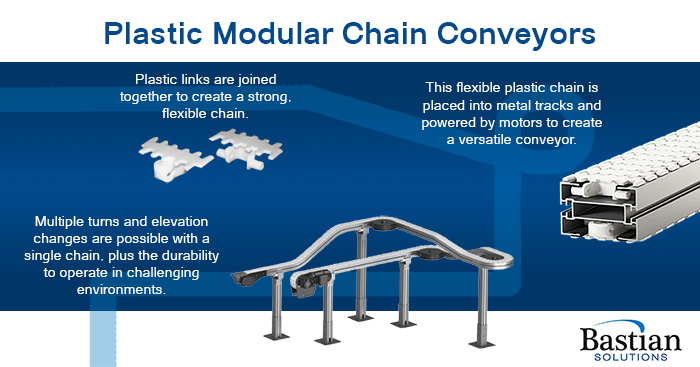
Surprising Applications for Plastic Modular Chain Conveyors
David Musch | 28 June 2018
Most of us think of plastic modular chain conveyors when looking at applications for clean, cool, or small products. Remarkably, they are equally suited for the opposite environment, conveying parts that are dirty, hot, and up to 80% wider than the chain they ride on. Because of their flexible path configuration and the variety of plastics available, plastic modular chain conveyors can be used in a surprisingly wide range of applications. Modular chain conveyor design is derived from nature to create strong and flexible conveyor designs.
Much like how individual vertebrae interlock to form a flexible spine, modular chain conveyor is created by joining together a series of links to create a chain. The plastic in these chains can be made with varied ingredients. Typically, Acetal Resin is the base plastic. To allow the chain to run in harsh environments, materials such as silicon, carbon fiber, polyvinylidene fluoride, and polyester are added. Aluminum profiles are commonly used to accommodate these specialized chains as well as match the environmental requirements.
This flexibility in chain design allows the conveyor to make turns and change elevations without transitions and run in a variety of extreme environments. With these attributes in mind, the following are five unique applications for plastic modular chain conveyor.
Sintered Metal Parts Manufacturing
Sintering is the process of compacting and forming a solid mass of material by heat or pressure without melting it to the point of liquefaction.* Many gears are made using sintering. Metal shot is loaded into a mold and compacted, then moved into a furnace in order to weld the individual balls of metal together. This transportation must be smooth to prevent cracking the compacted mid-stage product.
The conveyor surface must be softer than the metal to avoid marring the unheated metal, but must also be capable of handling 500-degree temperatures at the furnace inlet. Plastic chain conveyor provides a flexible, non-marring surface that when made with the appropriate materials, can handle high temperatures without issue.
Important Properties: non-marring, high temp
Anodizing Operations
The electrolytic passivation process used to increase the thickness of the natural oxide layer on the surface of metal parts.* Complex aluminum shapes can be sprayed with an acid solution while travelling on the plastic modular conveyor. As the plastic is also an insulator, the part can touch a current source to complete the anodizing process.
Important Properties: non-marring, chemical resistant, and electrically insulating
Degreasing/Washing Operations
A parts washer is a piece of equipment used to remove contaminants or debris, such as dirt, grime, carbon, oil, grease, metal chips, cutting fluids, mold release agents, ink, paint, and corrosion from workpieces.* Historically, stainless-steel mesh conveyors ran through washers. In recent years, modular belting has been increasingly used due to its ability to handle washing solvents, provide a non-marking surface for precision parts, and allow water to pass through the conveyor while surviving metal chips.
Important Properties: non-marring, chemical resistance, contaminant resistance
Hipot Voltage Testing
Hipot, short for high potential, is traditionally a term given to a class of electrical safety testing instruments used to verify electrical insulation in finished appliances, cables or other wired assemblies, printed circuit boards, electric motors, and transformers.* During this testing, electrical components are fed extreme voltages similar to lightning strikes, ensuring components don’t have dangerous flaws that could injure people working in close proximity.
These voltages heat components to high temperatures and must be cooled before packaging can take place. Typically, these components are made of fragile ceramics or metal. Plastic modular conveyors allow for the part to cool on a relatively soft, unmarking surface. They also allow paths that go around corners and up hills, avoiding potentially damaging transition points.
Important Properties: non-marring, non-metallic, static dissipative, minimal transitions
Aluminum Automotive Part Machining
The process of working with aluminum to create individual parts, assemblies, or large-scale structures.* Small parts make sense to convey with modular plastic belting, but there are advantages for larger parts as well. Historically, automotive frame cross members have been conveyed using roller, dual lane roller, overhead, or other heavy-duty conveyor systems. This was mainly due to weight. Now that aluminum is used for automotive frames and bodies, weight is not as big of a factor.
Typically, these components require a lot of precision milling to produce a product that can support other pieces of the car (think shock absorbers, struts, and engine mounts). A common way to move these components in and out of milling cells is with palletized modular chain conveyor. Precision fixtures mounted on top of 300mm wide pallets support 4’ long aluminum frame stock.
Important Properties: tight radius, chemical resistance, path flexibility The above examples provide a look at some challenging environments where plastic modular chain conveyors can excel. Understanding your application and working with an experienced and knowledgeable integrator will help you find the best plastic modular belting system for your situation.
*Definitions courtesy of Wikipedia
I am a Regional Manager with Bastian Solutions, overseeing the Michigan and northern Ohio field offices. With over 25 years of experience in managing projects and selling conveyor systems, I enjoy closely working with our Field Application Engineers and Project Engineers and their varied customers.
Comments
geometrydashdownload.co says:
8/28/2018 10:09 AM
This article gives clear idea designed for the new visitors
of blogging, that actually how to do blogging.
Leave a Reply
Your email address will not be published.
Comment
Thank you for your comment.